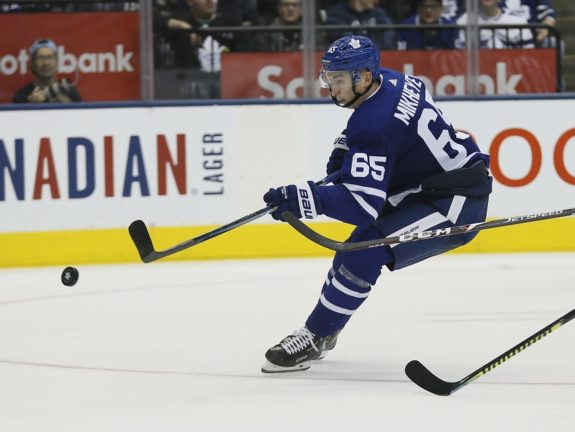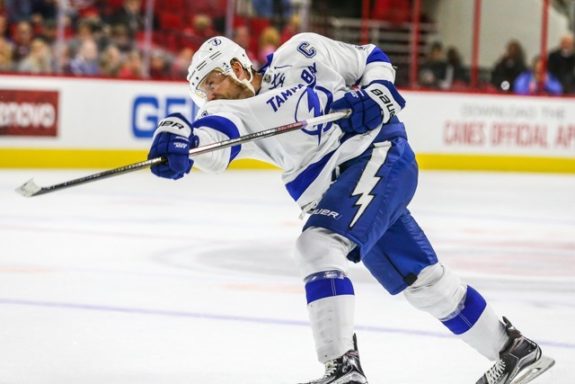There’s much to talk about early in the 2019-20 Toronto Maple Leafs season. Line combinations seems to be at the forefront, but there’s also the emergence of Rasmus Sandin, new defense pairings and, of course, the results.
What has seemed to fly under the radar to this point has been the work of the Maple Leafs’ special teams units. After all, the club brought in 33-year-old assistant Paul McFarland from the Florida Panthers due in part to his quality of work with a Panthers’ power play that ranked second last season with a 26.8% success rate.
At the other end of the bench is fellow newcomer Dave Hakstol who most recently resided as the head coach of the Philadelphia Flyers before being fired last December. Hakstol is largely responsible for the Maple Leafs’ penalty kill and is charged with turning that group around after they slipped into the bottom-half of the league last season.
On a weekly basis throughout the season, I’ll be reporting on the Maple Leafs’ special teams, their level of success, potential adjustments, strategy, personnel and, finally, a look at the upcoming schedule and what these groups will be up against over the next week.
It’s going to be a long and fun ride and I hope you’re coming along for the journey with me.
Power Play Succeeding
Of course, with a small sample size of just four games at this point, we need not get too carried away with what we are seeing with the Maple Leafs’ special teams and the results that follow. That said, the power play has worked to this point and both groups are getting their fair share of opportunities.
After loading his top unit with the likes of Auston Matthews, John Tavares, Mitch Marner, Morgan Rielly and the since-traded Nazem Kadri last season, Babcock has gone with a similar top group this time around with Andreas Johnsson filling in for Kadri, mostly as a net-front presence while Tavares taking Kadri’s spot as the high-slot bumper.

That said, the usage gap between the top unit and the second group has narrowed significantly. In fact, there are two members of the second power play unit that have averaged more man advantage ice time per game than Johnsson. Alexander Kerfoot (3:17) and Kasperi Kapanen (3:14) are both skating more than the 3:04 per game that Johnsson has seen on the power play.
There are two reasons for the change, and possibly a third. For one, the acquisition of Tyson Barrie added another elite power play defenseman to the Maple Leafs’ blue line. Jake Gardiner was a fine power play defenseman in his own right, but Barrie’s 56 points on the power play since the start of the 2017-18 season ranks third among NHL defensemen. Gardiner ranks 45th with 20 in that same span.
Secondly, the apparent bounceback season William Nylander is enjoying has added more zip, easier zone entries and a pass-shot threat to the right side. Nylander already has a goal and an assist on the man advantage while Barrie has collected a power play assist.
Finally, this could very well be by design. After come out of the gate white-hot last season, teams caught on to the Maple Leafs’ power play strategy as the season moved along, which focused heavily on Mitch Marner and his pass or shot options coming off the right wing. With two almost equally utilized groups — and seemingly two separate strategies — the 2019-20 version of the team’s power play appears to make it difficult for opponents to plan for.
All told, the Maple Leafs are clicking at 23.5% on the man advantage in the early going, a mark almost 2% higher than their season-ending 21.8% from last season. It’s a nice start and we’ll see how it goes from here.
Power Play Strategies
Unit 1
As noted, the Maple Leafs leaned heavily on Mitch Marner, armed with his elite vision and play-making ability, to create scoring chances by coming off the right side and either shooting, putting a slap-pass into the slot, going cross-ice to Matthews or down low to Tavares. That no longer appears to be the case.

It was documented in the summer that Matthews was attempting to expand his game by working on his one-timer on the off-wing, and it appears the Maple Leafs want to take advantage of that. He scored on a one-timer from the high-slot Saturday against the Montreal Canadiens at even strength, but also uncorked this beauty on a soft pass from Marner on the power play on opening night.
While Matthews sits on his off-wing, so does Marner. The team’s 2018-19 points leader now plays catch with Tavares in the high slot, feeds Rielly on the blue line, looks for Matthews cross-ice or goes down low to Johnsson in front of the goal. For a visual of just how different the set-up is from last season, check out Marner’s goal from Friday night in Columbus. We never would have seen such a strike from Marner a season ago.
McFarland’s setup is giving teams a whole new look at this Maple Leafs power play from the one that went stale down the stretch last season. It’s something the players are still learning, but there’s plenty to like about the new-look strategy.
Unit 2
The strategy for the second unit appears to resemble the strategy for the first unit from last season. One thing is for sure: Nylander and Barrie teaming up on this unit has perhaps made it the most dynamic second power play unit in the league.

Nylander is the primary puck-handler in this group, and he gets the choice of whether to pass or shoot coming off that right wing. In the middle of the ice is Kerfoot, while Kapanen and newcomer Jason Spezza reside either down low or on the far side for the cross-ice pass. While Nylander’s vision remains very good, his lethal wrister keeps goaltenders honest in not overplaying any potential pass. This could open up the cross-seam pass as we move forward.
We’ll also see more shots from the point and net-crashing on this second unit with Barrie as the triggerman. He’s already totaled 12 shots on the season, the most of any Maple Leafs defenseman and fourth on the team overall. The former Avalanche rear guard put 218 pucks on goal last season and his shot from the point will certainly factor in to the strategy of this second power play unit, more so than Rielly’s on the first group.
Penalty Kill Starts Strong
One of the least talked-about aspects of this Maple Leafs team has been a penalty kill that has been very good to start the season. However, if your penalty kill isn’t being prominently discussed, that’s probably a good thing.
The team’s penalty kill looks vastly different from last season thanks to the offseason departures of mainstays Connor Brown, Nikita Zaitsev and Ron Hainsey. Add in the Zach Hyman injury and the Maple Leafs are currently without their four most-utilized penalty killers from a season ago.

Cody Ceci is the team’s new minutes leader on the penalty kill while Jake Muzzin’s role on the kill has unsurprisingly increased as well. Add in Rielly and whoever is in the lineup between Martin Marincin and Justin Holl, and you have your four penalty-killing Maple Leafs defensemen.
Two rear guards you will not see on the penalty kill — barring a pinch — is Barrie and Sandin. In fact, Barrie is yet to see a single second on the penalty kill to this point while Sandin sits at :25 per game. Barrie’s minutes are best served as a puck-mover who can attack at the other end of the ice, especially in transition. At just 19 years old and four games into his NHL career, Mike Babcock will do everything he can to avoid putting Sandin into the penalty-killing fire at this juncture.
The forward group consists mostly of Marner, Kapanen, Mikheyev, Trevor Moore and the dual-centre duo of Spezza and Frederik Gauthier, mostly for faceoff purposes. However, both are going to see penalty killing time when they lose a defensive zone draw on the kill.
It’s Mikheyev who is currently the team’s minutes leader among forwards on the penalty kill. His tenacity on the puck combined with smooth strides for his 6-foot-3 form make him a dangerous killer at both ends of the ice. It appears the Maple Leafs have found a diamond in the rough not only for their third line, but their penalty kill as well.
Add it all up and the Maple Leafs have killed off 12 of 14 penalties to this point, good for an 85.7% success rate. Both the players and Hakstol have done their job in keeping goals off the board while short-handed.
Upcoming Schedule
Tampa Bay Lightning
The Maple Leafs’ penalty kill in particular is set for the stiffest of tests on Thursday night when they welcome the Tampa Bay Lightning to town. Jon Cooper’s crew isn’t exactly firing on all cylinders with a 1-1-1 mark through three games, but their power play was the best in the business last season with a 28.2% clip.

In 39 career games against the Maple Leafs, Markham, Ontario’s Steven Stamkos has scored 19 goals and notched 44 points. Six of those 19 tallies have come on the power play. For measure, he’s also scored a short-handed goal against his hometown team.
The Maple Leafs’ power play will have bring it’s “A” game on Thursday as well since the Lightning tied the Columbus Blue Jackets and Arizona Coyotes for the best penalty kill in the league at 85% a season ago. Forwards such as Anthony Cirelli and Alex Killorn are impact players on the kill while Ryan McDonagh has long been one of the best penalty-killing defenseman in the game.
Needless to say, the Maple Leafs will have their hands full against the Bolts on special teams on Thursday.
Detroit Red Wings
Never do you want to take any team lightly in this league, and the Maple Leafs would be wise to keep it that way when they visit the Detroit Red Wings on Saturday night at Little Caesars Arena. Jeff Blashill’s club already has upset victories over the Nashville Predators and Dallas Stars this season.

That said, there’s no doubt that this team struggled on special teams a season ago. The Red Wings ranked 28th with a 77.1% mark on the penalty kill while their power play checked in at 19th with a decent 18.1% clip. So far this season, their power play has struggled to the tune of an 8.3% clip (1 for 12), but their penalty kill matches the Maple Leafs at 85.7% (6 for 7).
Detroit still has some veterans that are effective on the kill in Darren Helm and Luke Glendening up front with Danny Dekeyser fitting that bill on the back end. Their power play also has nice young talent in the form of Dylan Larkin, Anthony Mantha and Tyler Bertuzzi — players more than capable of making you pay on the man advantage.
Still, anything short of winning the special teams battle against a projected bottom-feeding Red Wings club would be considered a failure.
Minnesota Wild
After facing the Red Wings in Detroit on Saturday, the team will get a couple of days off before hosting the Minnesota Wild on Tuesday — the first leg of back-to-back games next week.

The Wild aren’t a projected playoff club this season thanks to an aging core that fell well short last season. However, they do have one of the best emerging power play defensemen in Matt Dumba who flanks Suter along with veterans Zach Parise, Eric Staal and Mats Zuccarello on their top unit. This group won’t be easy to defend and are still dynamic despite the advanced ages. The Wild are 2 for 7 (28.6%) on the power play to this point.
The Wild are built on defense and goaltending with Devan Dubnyk never an easy beat. Minnesota has killed all but one of their eight penalties this season, good for an 87.5% clip. Their penalty kill was also very good a season ago, ranking 7th with an 81.7% rate on the kill. Needless to say, power play goals won’t come easy on Tuesday.
I will get these pieces out every Wednesday for the duration of the NHL season, and we’ll have a larger sample size to speak of before the Maple Leafs take on the Washington Capitals in the tail end of their back-to-back set on Wednesday in Washington. They’ll certainly face a dangerous power play in that one against Alex Ovechkin and company, putting their new-look penalty kill to the test again.
Thanks for following along and we will see you next week!